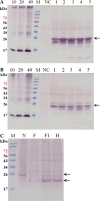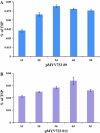Immunogenicity of a neutralizing epitope from porcine epidemic diarrhea virus: M cell targeting ligand fusion protein expressed in transgenic rice calli
- PMID: 22736145
- PMCID: PMC7080027
- DOI: 10.1007/s00299-012-1306-0
Immunogenicity of a neutralizing epitope from porcine epidemic diarrhea virus: M cell targeting ligand fusion protein expressed in transgenic rice calli
Abstract
To increase immune responses of plant-based vaccines in intestine mucosal immune systems, a synthetic neutralizing epitope (sCOE) gene of porcine epidemic diarrhea virus (PEDV) was fused with M cell-targeting ligand (Co1) and introduced into a plant expression vector under the control of rice amylase 3D promoter. The sCOE-Co1 fusion gene was introduced into rice calli via the particle bombardment-mediated transformation method. The stable integration and transcriptional expression of the sCOE-Co1 fusion gene was confirmed by genomic DNA PCR amplification and Northern blot analysis, respectively. The expression of the COE-Co1 fusion protein was confirmed by immunoblot analysis. The highest expression level of the COE-Co1 fusion protein reached 0.083 % of the total soluble protein according to quantitative densitometry of Western blot analysis. Mice immunized with transgenic rice calli protein extracts induced significant serum IgG and fecal IgA antibody levels against purified bacterial COE. The systemic and mucosal immune responses were confirmed by measuring COE-specific IgG and IgA antibody-secreting cells in the lymphocytes extracted from the spleen and COE-specific IgA antibody-secreting cells in the Peyer's patches from immunized mice. These results indicated that oral immunization of plant-produced COE-Co1 fusion protein could elicit efficient systemic and mucosal immune responses against the COE antigen. Key message Neutralizing epitope from porcine epidemic diarrhea virus-M cell targeting ligand fusion protein was produced in transgenic rice calli and elicited systemic and mucosal immune responses by oral administration in mice.
Figures






Similar articles
-
Expression of a cholera toxin B subunit-neutralizing epitope of the porcine epidemic diarrhea virus fusion gene in transgenic lettuce (Lactuca sativa L.).Mol Biotechnol. 2011 Jul;48(3):201-9. doi: 10.1007/s12033-010-9359-1. Mol Biotechnol. 2011. PMID: 21153716
-
M cell-targeting ligand and consensus dengue virus envelope protein domain III fusion protein production in transgenic rice calli.Mol Biotechnol. 2013 Jul;54(3):880-7. doi: 10.1007/s12033-012-9637-1. Mol Biotechnol. 2013. PMID: 23250723
-
Oral immunization with a Lactobacillus casei-based anti-porcine epidemic diarrhoea virus (PEDV) vaccine expressing microfold cell-targeting peptide Co1 fused with the COE antigen of PEDV.J Appl Microbiol. 2018 Feb;124(2):368-378. doi: 10.1111/jam.13652. J Appl Microbiol. 2018. PMID: 29178509
-
Recent advances and safety issues of transgenic plant-derived vaccines.Appl Microbiol Biotechnol. 2013 Apr;97(7):2817-40. doi: 10.1007/s00253-012-4566-2. Epub 2013 Mar 1. Appl Microbiol Biotechnol. 2013. PMID: 23447052 Free PMC article. Review.
-
The green vaccine: A global strategy to combat infectious and autoimmune diseases.Hum Vaccin. 2009 Jul;5(7):488-93. doi: 10.4161/hv.8247. Epub 2009 Jul 23. Hum Vaccin. 2009. PMID: 19430198 Free PMC article. Review.
Cited by
-
Plant-based oral vaccines against zoonotic and non-zoonotic diseases.Plant Biotechnol J. 2016 Nov;14(11):2079-2099. doi: 10.1111/pbi.12604. Epub 2016 Aug 23. Plant Biotechnol J. 2016. PMID: 27442628 Free PMC article. Review.
-
Oral Administration of Coronavirus Spike Protein Provides Protection to Newborn Pigs When Challenged with PEDV.Vaccines (Basel). 2021 Nov 30;9(12):1416. doi: 10.3390/vaccines9121416. Vaccines (Basel). 2021. PMID: 34960163 Free PMC article.
-
Improved expression of porcine epidemic diarrhea antigen by fusion with cholera toxin B subunit and chloroplast transformation in Nicotiana tabacum.Plant Cell Tissue Organ Cult. 2019;137(2):213-223. doi: 10.1007/s11240-019-01562-1. Epub 2019 Feb 2. Plant Cell Tissue Organ Cult. 2019. PMID: 32214566 Free PMC article.
-
Dengue virus E glycoprotein production in transgenic rice callus.Mol Biotechnol. 2014 Dec;56(12):1069-78. doi: 10.1007/s12033-014-9787-4. Mol Biotechnol. 2014. PMID: 25069989
-
Roles of M cells in infection and mucosal vaccines.Hum Vaccin Immunother. 2014;10(12):3544-51. doi: 10.4161/hv.36174. Hum Vaccin Immunother. 2014. PMID: 25483705 Free PMC article. Review.
References
-
- Cavanagh D (2005) Coronaviridae: a review of coronaviruses and toroviruses. Birkhäuser Verlag, Basel, pp 1–54
-
- Cavanagh D, Britton P (2008) Coronaviruses: general features. Encyclopedia of virology. Academic Press, New York, pp 549–554
-
- Chang SH, Bae JL, Kang TJ, et al. Identification of the epitope region capable of inducing neutralizing antibodies against the porcine epidemic diarrhea virus. Mol Cells. 2002;14:295–299. - PubMed
Publication types
MeSH terms
Substances
LinkOut - more resources
Full Text Sources
Other Literature Sources
Miscellaneous

